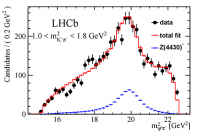LHCb experiment at CERN confirms existence of exotic resonance

Edinburgh physicists, working on the LHCb experiment at CERN, have confirmed the existence of an exotic combination of four quarks/antiquarks that does not fit into the normal particle zoo of baryons and mesons.
A new measurement performed by the LHCb collaboration, one of the four large experiments at the LHC at CERN, has confirmed the existence of the exotic object labelled the Z(4430)-. This particle does not fit into the pattern of particles we have seen up to now. The LHCb result confirms an observation made by the Belle collaboration in 2008 that was later questioned and so resolves this previously unclear situation.
We and everything around us are made of atoms, and atoms are made in turn of smaller constituents. Atomic nuclei are orbited by electrons. The protons and neutrons that form atomic nuclei consist of three fundamental particles, called quarks, bound together. Other combinations of quarks can occur - particles containing two bound quarks (mesons) are also seen in nature. However, until now all particles containing quarks (hadrons) have conformed to one of these two types; quarks seem to like to come in twos or threes.
However, the underlying theory of quantum chromodynamics (QCD) that describes the behaviour of quarks allows for many different quark combinations, such as four quark states, to bind together into hadrons. Over the last forty years many searches for such exotic states have been performed but until now there was no conclusive proof of their existence. Several more mundane explanations for the Z(4430)- signal seen by Belle had been put forward, but the LHCb result establishes that for the first time we have seen the “smoking gun” signal for resonant behaviour of a particle contains at least four quarks/antiquarks.
The strange name, Z(4430)-, indicates that the particle has a mass of approximately 4430 MeV/c2, roughly four times heavier than a proton. In addition, the “-“ sign tells us that the state is negatively charged. The LHCb collaboration have also made a measurement of the spin and parity of this state, two fundamental properties (quantum numbers) that characterise its nature.
"This is a fantastic result from the LHCb collaboration. It confirms previous signs of this exotic state and shows, for the first time, that it has has the characteristic behaviour of a resonance. In addition we have also been able to pin down the quantum numbers and properties of this state with higher precision than previous experiments. The next step is to look for further signs of this state in the large sample of data that we have already collected."Greig Cowan, STFC Ernest Rutherford Fellow at the University of Edinburgh and one of the lead analysts on this result.
"This is tremendous result, demonstrating the existence of new exotic hadronic states and shows the power of the large dataset collected by LHCb to make new discoveries."Matthew Needham, Chancellor's Fellow at the University of Edinburgh, is the UK physics co-ordinator for the LHCb experiment.

